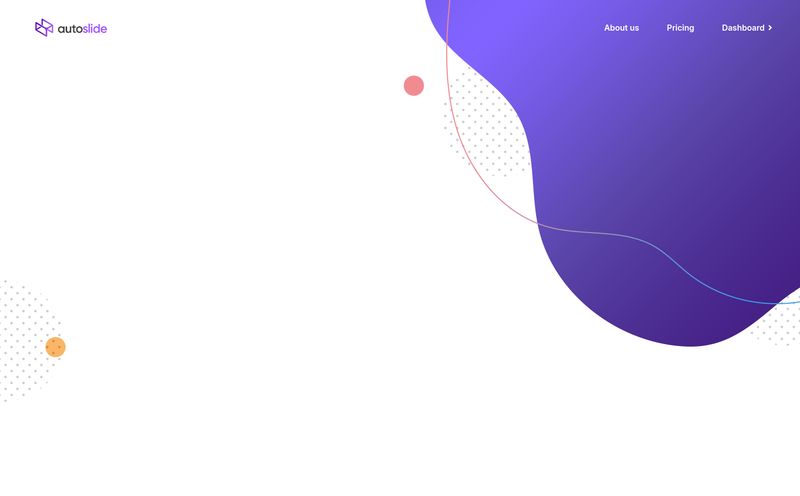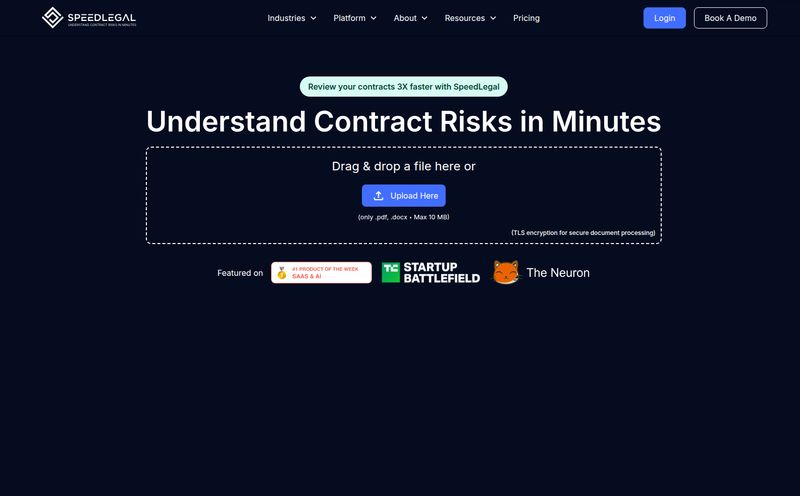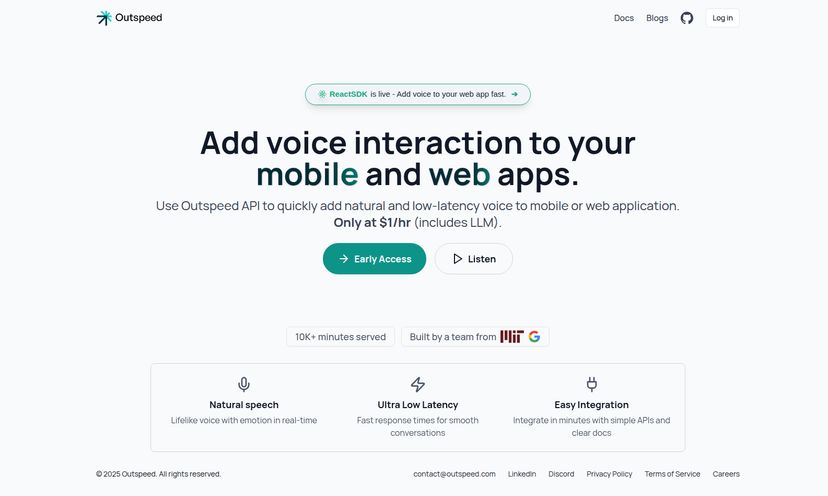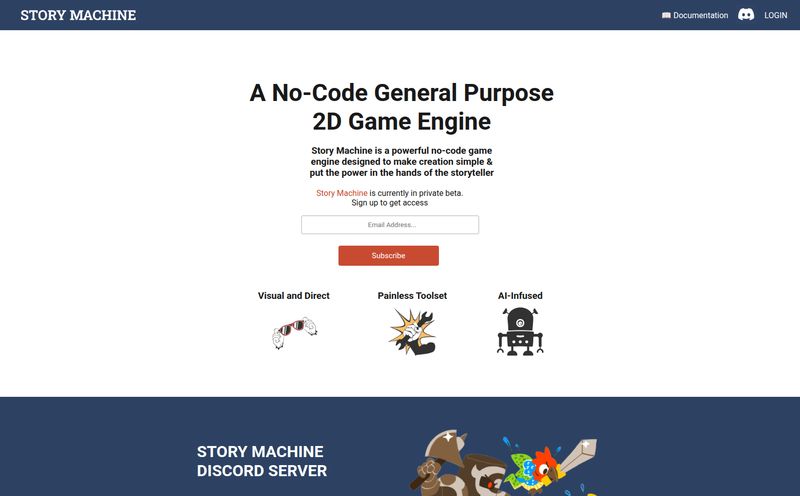If you've spent any time in the last year trying to build something... useful... with a Large Language Model, you know the feeling. The initial thrill of seeing GPT-4 or Llama 3 write a poem is quickly replaced by the cold, harsh reality of infrastructure. Suddenly, you're not a creative developer anymore; you're a frustrated plumber trying to connect a dozen leaky pipes labeled 'Vector DB', 'API Gateway', 'Context Window', and 'God-Help-Me-Now'.
I've been there. My desk has the coffee stains and scattered whiteboard drawings to prove it. You spend 80% of your time on the boring glue code and only 20% on what actually makes your AI agent special. It's a grind. So when I see a platform pop up with a slick landing page that says, "Vibe code agents with superpowers," my inner cynic and my hopeful innovator have a little argument. The cynic scoffs, but the innovator leans in. That's where I found myself with Toolhouse.
It promises to be a complete cloud infrastructure for LLMs, letting you deploy smart AI agents with just a few lines of code. A bold claim. But after seeing it's trusted by companies like Nvidia and Salesforce, I figured it was worth more than a passing glance.
What’s the Big Deal with AI Agents, Anyway?
For a minute, let's zoom out. The whole AI space is moving past simple Q&A chatbots. We're in the era of agents. These aren't just language models that talk; they're models that do things. They can check your calendar, book a flight, analyze a competitor's website, or manage your customer support tickets. They have tools, memory, and goals.
But building one from scratch? Oof. It’s a mess. You have to handle function calling so the LLM can actually use an API. You need to implement Retrieval-Augmented Generation (RAG) so it has up-to-date knowledge and doesn't just make stuff up. You need to manage memory, so it remembers the conversation from five minutes ago. Each of these is a major engineering project on its own. Stitching them together often feels like building a car from parts you found in four different junkyards. It might run, but you wouldn't trust it on the highway.
So, What on Earth is Toolhouse?
This is where Toolhouse steps in and tries to clean up the garage. In my own words, Toolhouse is a Backend-as-a-Service (BaaS) specifically for AI agents.
Think about what platforms like Vercel or Netlify did for web development. You stopped worrying about configuring servers and SSL certificates and just focused on writing your code. Toolhouse aims to do the exact same thing for the world of agentic AI. It's an abstraction layer that handles the frustrating, complex backend infrastructure, so you can focus on the fun part: defining what your agent should actually do.
The core concept is ridiculously appealing. Instead of manually integrating a vector database, setting up scrapers, and writing complex prompt chains, you get a platform where most of that is pre-loaded. The comparison chart on their site is pretty telling: it’s the classic “hours of painful setup” vs. “a few clicks and you’re building.”
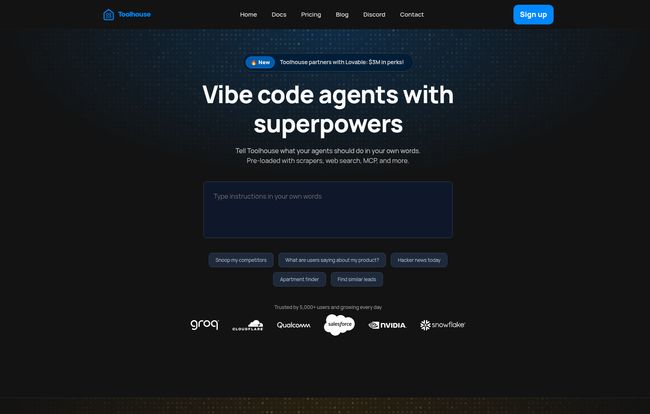
Visit Toolhouse
The Features That Actually Matter
A feature list is just a list. What I care about is how those features solve my real-world problems. Here’s my breakdown of what caught my eye.
Goodbye, Function Calling Headaches
Getting an LLM to reliably call an external API or tool is… a dark art. You format your prompts just so, you pray the model outputs the right JSON, and you write tons of error-handling code for when it inevitably messes up. Toolhouse is built around this idea of giving agents "tools." It simplifies this process, providing the framework to make those connections less brittle and more declarative. This alone could save days of development time.
RAG and Memory Without the Migraine
Everyone's talking about RAG, and for good reason. It's how you give your agent proprietary or real-time knowledge. But implementing it well is a beast. You need to set up a vector database, manage chunking and embedding... it's a whole thing. Toolhouse comes with RAG built-in. This is huge. The same goes for memory. An agent that can't remember the last thing you said is useless. Toolhouse provides built-in, fast memory and context management, which is another one of those deceptively hard problems solved for you.
The Agent Studio: Are We Coding in English Now?
This is probably the most intriguing part. The landing page prompts you to "Type instructions in your own words." The platform includes an 'Agent Studio' for building agents using plain language. Now, I'm a coder, I like code. But the idea of rapidly prototyping an agent's logic by just… describing it? That's a powerful concept. It lowers the barrier to entry and could make iteration incredibly fast. I'm curious to see how deep this goes, but as a starting point, it's a fascinating direction.
One-CLI-Command Deployment
Once you've built your masterpiece, you don't want to spend a week figuring out how to deploy it. Toolhouse offers a CLI (Command-Line Interface) for deployment. For any developer, this is a familiar and welcome workflow. It brings the simplicity of modern web deployment to the AI agent world.
Let's Talk Money: Toolhouse Pricing Breakdown
Okay, the shiny features are great, but what's it going to cost me? This is often the point where my interest evaporates. But honestly, the pricing structure for Toolhouse seems pretty well thought out. They have a classic tiered model that scales with you.
| Plan | Price | Best For |
|---|---|---|
| Sandbox | $0 / month | Hobbyists and curious developers just wanting to kick the tires. 50 agent runs is enough to see if you like it. |
| Pro | $10 / month | The sweet spot. For indie hackers, startups, and serious projects. 1,000 runs and private agents make this a real value proposition. |
| Business | $850 / month | Growing companies that need more volume, team features, and priority support. Human-in-the-loop is a key feature here. |
| Enterprise | Custom | The big leagues. For when you need dedicated support, compliance, and custom infrastructure. |
My take? The free Sandbox tier is genuinely useful for trying things out. But the Pro plan at $10 a month feels like an absolute steal. For the price of a couple of fancy coffees, you're offloading a mountain of complex infrastructure work. That's a trade I'd make any day. The jump to Business is significant, but it's clearly for teams where the agent is a core part of their product and generating revenue.
The Good, The Bad, and The Agentic
No tool is perfect. It's always a game of trade-offs. So, here's my unfiltered perspective.
The Upside is obvious. The reduction in development time is massive. You get to stand on the shoulders of giants and not reinvent the wheel for the tenth time. Having RAG, evals, and memory out of the box is a dream. And because their SDK is designed to be compatible with any LLM, you're not locked into a specific model. You can swap in whatever is the new hotness next week.
Now, for the Potential Gotchas. First, there's the classic platform dependency. By building on Toolhouse, you're tying your agent's fate to their infrastructure. This is the standard BaaS trade-off: you sacrifice some control for a massive gain in speed and convenience. For most projects, thats a good trade. Second, while it simplifies things, there will still be a learning curve specific to the Toolhouse way of doing things. And finally, as you scale, the pricing could become a factor, though I’d argue if your agent is running 100,000+ times a month, it should be paying for itself by then.
Who Should Give Toolhouse a Spin?
I see a few clear groups who should be signing up for the free tier right now.
- Indie Hackers & Startups: If you want to build and launch an AI-powered MVP in weeks instead of months, this is for you. Speed is your biggest advantage, and Toolhouse is built for speed.
- Established Dev Teams: For teams looking to add agentic capabilities to an existing product without derailing their entire roadmap to build the infrastructure. Its a fantastic way to experiment and integrate.
- Product Managers & Designers: The Agent Studio, in particular, could be a game-changer for less technical folks to prototype agent behavior and logic.
Who is it maybe not for? If you're a research scientist or a company that needs absolute, bare-metal control over every single component of your AI stack for performance or proprietary reasons, you're probably going to build it all yourself anyway. And that's okay.
At the end of the day, the AI gold rush isn't about who can build the best pickaxes; it's about who can find the gold. The market is flooded with tools to build AI, but most of them are just better pickaxes. Toolhouse feels different. It feels more like a map, a guide, and a pack mule all in one, designed to get you to the gold faster. It abstracts away the most painful parts of AI agent development, letting you focus on creating value. And in this incredibly fast-moving space, that might be the only advantage that truly counts.
Frequently Asked Questions
- What is Toolhouse?
- Toolhouse is a cloud platform, specifically a Backend-as-a-Service (BaaS), that provides all the necessary infrastructure to build, deploy, and manage AI agents. It includes built-in features like RAG, memory, and function calling to speed up development.
- What does the free plan include?
- The free Sandbox plan is great for getting started. It includes 50 agent runs per month, the ability to create unlimited (but public) agents, and access to the core platform features to see how it all works.
- How much does it cost to use?
- Toolhouse has a free tier. Paid plans start at $10/month for the Pro tier, which includes more agent runs and private agents. The pricing scales up from there for Business and Enterprise needs, based on usage and required features.
- Who owns the agents and their data?
- This is a critical question for any SaaS platform. According to standard practices and their business-focused plans, you own your agents and the data they process. For sensitive applications, the Enterprise plan offers options for private data hosting and increased compliance.
- Is Toolhouse good for beginners in AI development?
- Absolutely. In fact, it's one of its main strengths. By handling the complex backend setup, it allows someone newer to AI to focus on the logic of their agent without needing a PhD in vector databases. The Agent Studio, which uses plain language, lowers the barrier even further.
- Can I use any LLM with Toolhouse?
- Yes, the platform is designed to be model-agnostic. Through its SDK, you can integrate with any Large Language Model, so you're not locked into a single provider like OpenAI or Anthropic. You can use whatever model best fits your agent's needs and budget.
Reference and Sources
- Toolhouse Official Website
- Toolhouse Pricing Page
- What Is RAG? (from a16z) - For a deeper look into the tech Toolhouse helps manage.
